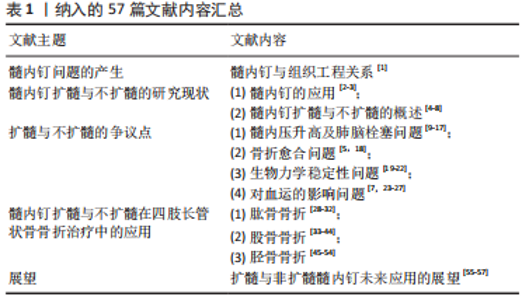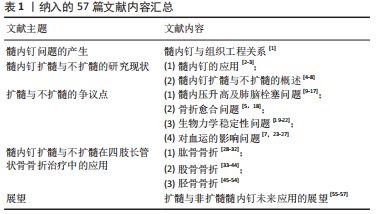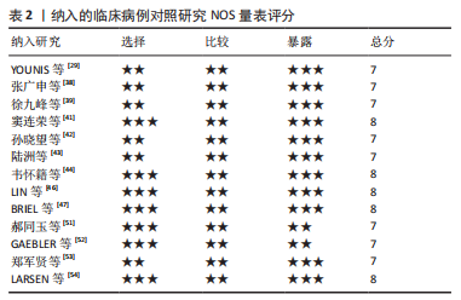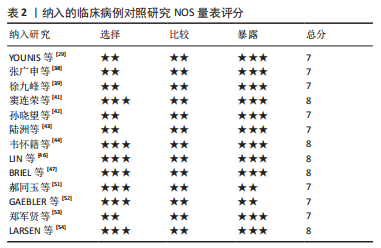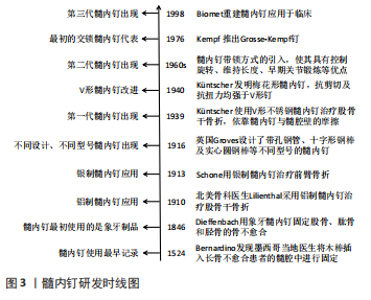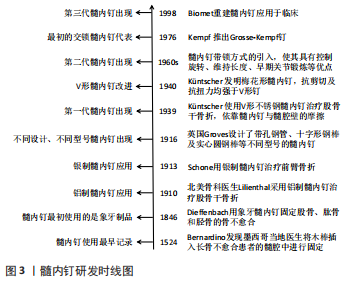Chinese Journal of Tissue Engineering Research ›› 2022, Vol. 26 ›› Issue (3): 461-467.doi: 10.12307/2022.076
Previous Articles Next Articles
Application of intramedullary nailing in the treatment of long tubular bone fractures of the extremities: reaming and non-reaming
Liu Zemin, Lü Xin
- Department of Orthopedics, Second Hospital of Shanxi Medical University, Taiyuan 030001, Shanxi Province, China
-
Received:2021-04-12Revised:2021-04-15Accepted:2021-05-26Online:2022-01-28Published:2021-10-29 -
Contact:Lü Xin, Chief physician, Department of Orthopedics, Second Hospital of Shanxi Medical University, Taiyuan 030001, Shanxi Province, China -
About author:Liu Zemin, Master candidate, Department of Orthopedics, Second Hospital of Shanxi Medical University, Taiyuan 030001, Shanxi Province, China
CLC Number:
Cite this article
Liu Zemin, Lü Xin. Application of intramedullary nailing in the treatment of long tubular bone fractures of the extremities: reaming and non-reaming[J]. Chinese Journal of Tissue Engineering Research, 2022, 26(3): 461-467.
share this article
Add to citation manager EndNote|Reference Manager|ProCite|BibTeX|RefWorks
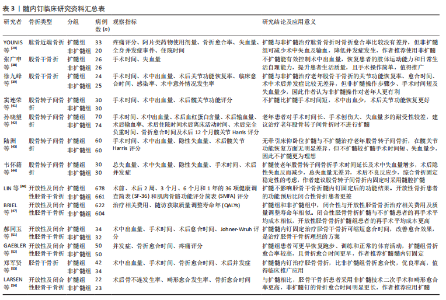
(2)研究资料汇总,见表3。 2.2.1 髓内钉的应用 髓内钉的使用最早源于16世纪人类学家Bernardino的记录,他在墨西哥发现当地医生将木棒插入长骨不愈合患者的髓腔中进行固定,其他20世纪前的髓内技术也经常被用于长骨骨不连患者的治疗。直到1939年KüNTSCHER报道使用V形不锈钢髓内钉成功治疗股骨干骨折开始,金属髓内钉在急性长骨骨折患者中的应用迅速扩大[2]。髓内钉设计之初,主要靠髓钉与髓腔内壁的紧密接触来维持结构的稳定。随着带锁技术的应用,钉骨结构的稳定性不再依赖于接触摩擦,部分应力分散于锁钉与皮质接触处,髓内钉的适应范围变得更加广泛[3]。由于髓内钉是闭合及微创置入,可保护骨折周围软组织,保证良好的软组织覆盖,并降低了骨折暴露带来的术后感染风险。髓内钉固定为中心固定,承载负荷使应力较分散,避免了应力遮挡作用,再骨折发生率降低;其牢固的固定可使患者术后早期进行功能锻炼和负重,降低术后并发症的出现。带锁髓内钉还可有效控制骨折部位的轴向力线,防止骨折旋转畸形,降低了内置物断裂的风险。髓内钉具有的以上优势使其在临床的应用越来越广泛。 2.2.2 髓内钉扩髓与不扩髓的概述 随着髓内钉使用的日益增多,关于髓内钉置入髓腔扩髓与不扩髓的讨论也在逐渐增多。通过扩髓置入髓内钉存在一些优势:①它保证了髓内装置的通过性。在没有扩髓的情况下插入髓内钉可能会导致钉子嵌顿,无法插入该装置。②扩髓后允许插入更大直径的髓内钉。在早期的髓内钉设计中,更大直径的髓内钉提供了更高的扭转和侧弯刚度,以及更强的抗疲劳破坏能力,从而增加了内固定的耐久性。③扩髓后插入大直径的髓内钉增加了髓内钉和内层骨皮质的接触,从而增加了骨折结构的稳定性,特别是在抗旋转方面[4]。一些动物实验研究表明,扩髓使髓腔扩大,使其中内容物排出,方便植入更大直径的髓内钉主钉,增大其接触面积,使抗折弯能力更大,避免了内固定断裂,并且扩髓时产生骨碎屑积聚于骨折断端,可形成内植骨效应[5]。扩髓置入髓内钉也存在一些问题:最常见的是由于扩髓导致髓内压迅速升高,迫使脂肪栓子或骨髓微小颗粒通过破裂的静脉窦进入血液循环发生栓塞现象[6];扩髓时钻头的高速旋转会引起骨内膜血供的破坏,一方面导致骨内膜缺少血液供应影响骨折愈合,另一方面骨内膜坏死区的形成可能会导致感染出现,进一步造成引起感染性骨不连。 非扩髓置入髓内钉的优势是:①减少手术时间和透视次数。置入髓内钉时不需要先插入导针再扩髓,开口后可直接插入主钉,阻力较大时即证明进入了髓腔,不再需要透视确认;②不需要扩髓,可以采用更小的手术切口,不必担心切口周围软组织对导针和套筒置入的干扰,同时避免了钻头对开口周围组织的损伤,避免了组织损伤引起的疼痛症状出现;③置入较小的髓内钉能较好地保存骨内血流量,并且可能更迅速地恢复骨内膜血运[7];④非扩髓短的手术时间和小的手术切口减少了术中和术后失血。非扩髓置入髓内钉存在的问题是内植物失效率高,特别是锁钉部位,可能的原因是:①直径较小的髓内钉与髓腔接触面积有限,抗轴向旋转能力差,增加了锁钉断裂的概率;②非扩髓髓内钉配套的锁钉也相对较小,在钉骨接触面积减小的情况下,锁钉处承载较大的负荷,也易造成锁钉疲劳断裂[8]。 2.3 扩髓与不扩髓的争议点 2.3.1 髓内压升高及肺脑栓塞问题 扩髓会引起髓内压力的升高,从而增加脂肪栓塞发生的风险,最常见于股骨干骨折。单纯肱骨干或胫骨干骨折的扩髓治疗不会引起脂肪栓塞发生率的明显增加,当合并股骨干骨折时,就需要慎重选择扩髓技术[9]。相关研究发现,虽然扩髓和非扩髓髓内钉的使用都会引起肺部指标的改变,这种改变是暂时的,但扩髓时比非扩髓更明显[10]。HEIM等[11]研究了扩髓人胫骨和股骨髓腔时髓内压的变化。他们在骨的远端放置了一个压力计,用于记录压力的变化。研究发现,在骨的近端开口时压力并不会大幅上升,而在放置导丝时髓内压力会迅速上升;在扩髓和插入髓内钉时会出现两次压力高峰,但在髓内钉植入后,压力随即趋于平稳。MOUSAVI等[12]研究发现,扩髓时钻头的转速越快、推进速度越慢,髓内压升高幅度越小。因此他推荐使用锋利的钻头,较细的推进杆,以高转速、缓慢推进扩髓。扩髓对于髓内压升高的影响是一过性的,合理运用扩髓技术可有效降低髓内压升高的幅度。 关于肺脑栓塞的发生机制,陈中伟等[13]认为,扩髓及植入髓内钉的过程破坏了髓内血管,升高的髓内压将组成黄骨髓的脂肪挤入骨的营养血管,进一步经骨膜及皮质附近的血管流入血液循环,最后进入肺部。KROPFL等[14]认为进入肺部的脂肪数量较大时,可激活肺泡膜上的脂酶,将脂肪水解为甘油和游离脂肪酸,进一步诱导血小板及细胞炎性介质的趋化,引起急性炎症反应的发生,这些反应可导致肺水肿、急性呼吸窘迫综合征或肺部脂肪栓塞的出现,反应较重时可出现脑部症状。BAIG等[15]报道了一种髓内灌洗方法,在髓内钉插入前,通过限制髓内物质的数量,防止长骨骨折扩髓髓内钉置入术中及术后的栓塞。WILLIS等[16]通过动物实验观察应用扩髓或不扩髓髓内钉治疗骨折对肺毛细血管通透性的影响,并记录肺动脉压和中性白细胞的变化,结果发现扩髓或不扩髓髓内钉均可引起肺毛细血管通透性的升高,不扩髓髓内钉固定还可引起中性白细胞增多,但最终均未观察到肺功能的明显损害,他认为肺功能的损害是多因素相互作用的结果,扩髓与不扩髓不是直接因素。AOKI等[17]将18只绵羊平均分为扩髓股骨髓内钉组、非扩髓股骨髓内钉组和假手术对照组,来观察扩髓与非扩髓对绵羊肺功能和凝血反应的影响,结果发现3组间血流动力学监测数据、血气分析、不同时间点生化指标均无显著性差异,他认为,扩髓在生理水平上并不会影响肺功能。 2.3.2 骨折愈合问题 扩髓通过干扰骨皮质血运影响骨折愈合。扩髓导致骨干向心血流代替离心血流,这对骨折的愈合有积极作用[5]。向心血流的形成是因为在扩髓过程中,髓内血供虽受影响,但代偿性骨外膜血运增加,逐渐形成以骨外膜向内供血的血液循环。同时骨折处释放大量促进骨折愈合的生长因子,可使骨折部位成骨作用明显增强。 黄正[5]对大鼠股骨不稳定性骨折不愈合模型采用扩髓髓内钉固定和不扩髓髓内钉固定2种治疗措施,观察骨折断端组织的细胞因子、碱性磷酸酶及Ⅱ型胶原表达,结果发现扩髓并更换粗直径髓内钉治疗组的骨折愈合率达92.96%,不扩髓治疗组骨折愈合率6.25%,与不扩髓组相比,扩髓组骨折断端不同时期细胞因子、碱性磷酸酶和Ⅱ型胶原表达都会提高。扩髓用于骨折不愈合的治疗,可解除不同环节障碍,并启动骨折愈合。DEHGHAN等[18]认为长骨扩髓能够获得大量的骨皮质、松质骨屑,这些骨碎屑可发挥髓内化骨的作用,相当于髓内植骨,这将有助于骨折的愈合。扩髓可促进骨折愈合得到了动物实验的支持,这其中起主要作用的是扩髓产生的骨碎屑等物质。 2.3.3 生物力学稳定性问题 下肢负重长管状骨骨折采用髓内钉固定可保持肢体长度,远近端锁钉可控制旋转,负重时可刺激骨痂形成、骨折愈合,同时骨折端均匀承受应力,避免了剪切力、扭转力的产生,符合骨折愈合所需的力学环境。 扩髓与不扩髓对骨折固定的生物力学影响集中在髓内钉直径的选择上。CLAES[19]认为扩髓后较大的髓腔可插入直径更大的髓内钉,可提高钉骨接触面积,减小远端锁钉与皮质及主钉接触处的应力,保护主钉、锁钉不易断裂失效;同时,直径大、强度高的髓内钉可使内固定整体稳定性更高;而非扩髓髓内钉由于髓内钉直径较小,与髓腔接触有限,甚至可能产生旋转应力,使远端锁钉处应力集中,容易造成内固定失效。这与徐绍勇[20]观点一致。孙林等[21]分析髓内钉远端锁钉处骨折的原因,可能与锁钉误锁、出现沉钉或浮钉时多次钻孔有关。同时,过于强调扩髓导致骨皮质过薄也会出现骨折的情况。除此之外,有研究发现扩髓从10 mm到12 mm,骨的应变增加13%,从12 mm扩髓到14 mm,骨的应变增加25.5%,再从14 mm扩髓到16 mm,骨的应变增加70%[22]。在施加的负荷不变的情况下,应变的增加表明骨强度的降低。这提示不能一味地追求扩髓,适度利用扩髓技术在保证骨强度的同时,置入较大直径髓内钉才能有效提高整体的生物力学稳定性。 2.3.4 对血运的影响问题 扩髓可导致髓内微血管的热损伤或直接损伤,因此非扩髓髓内钉固定理论上可获得更好的髓内血运环境。任强[7]认为扩髓会加重骨内膜血运的损伤,可能会导致骨折不愈合及延迟愈合的发生;非扩髓髓内钉的应用可以相对更好地保护骨内膜血运,并尽可能快的恢复骨的血液供应。这得到了一些研究者的支持[23-24],他们认为扩髓破坏了70%的骨内膜血流量,非扩髓破坏了30%,扩髓髓内钉的应用使骨皮质血流更难恢复正常。KLEIN[23]通过扩髓与非扩髓髓内钉治疗犬胫骨骨折,采用Procion红活体染色显示血运受到影响的部位。结果发现扩髓髓内钉干扰了2/3以上的皮质厚度的灌注,并在局部延伸到整个皮质厚度;使用非扩髓髓内钉时血运干扰局限于皮质内层,仅涉及皮质横截面积的1/3。作者认为扩髓髓内钉与非扩髓髓内钉在皮质供血范围上有明显差异,非扩髓髓内钉比扩髓加髓内钉更好地保护了骨循环。这与KLEIN等[25]研究结果一致。 扩髓破坏了骨内膜血运,骨的血运分布可能因此发生改变。KALBAS等[26]在标准麻醉和重症监护条件下对猪的标准化股骨骨折模型进行扩髓髓内钉治疗,结果发现与其他治疗方式相比,髓内扩髓治疗猪的骨折局部血液微循环(血流量和氧气输送)显著增加。黄正[5]的研究发现,肥大的骨痂、骨外膜血管代偿性增生,使离心性血流变为向心性,有利于血管生成。GREKSA等[27]通过显微外科方法扩髓雄性Wistar大鼠右侧胫骨后植入髓内钉。对胫骨骨膜的前内侧和前外侧表面进行显微镜检查,评估血管和毛细血管密度变化。结果发现,胫骨扩髓术后12周可见骨膜前内侧血管生成增强,两侧毛细血管生成增强,他认为扩髓后骨膜表面血运将发生代偿性增生,以弥补髓内血运。 2.4 髓内钉扩髓与不扩髓在四肢长管状骨骨折治疗中的应用 2.4.1 肱骨骨折 长骨髓腔的峡部是阻挡髓内钉置入的重要解剖因素,肱骨峡部居于肱骨中下1/3交界处,且髓腔从峡部到肱骨远端近似圆柱结构,直径几乎不变,直至髁上部位。这一解剖特点使髓内钉不能到达肘关节水平,因此肱骨远端骨折无法用髓内钉治疗。李云等[28]研究发现,不扩髓逆行交锁髓内钉是治疗肱骨中段骨折的一种理想的方法。他认为扩髓破坏了骨内膜血运,髓内压升高,可能诱发成人呼吸窘迫综合征和脂肪栓塞综合征等并发症。由于髓内径较小,扩髓时震动可能损伤桡神经。YOUNIS等[29]对53例肱骨骨折患者进行髓内钉固定治疗,其中扩髓组33例,不扩髓组20例。结果发现,扩髓组与不扩髓组疼痛评分和阿片类药物使用剂量无显著差异,扩髓组与不扩髓组骨折愈合率也没有差异,但不扩髓组失血量少、全身并发症事件少和住院时间短,他推荐使用不扩髓髓内钉治疗肱骨骨折。 BALTOV等[30]对股骨干骨折采用髓内钉固定的术后并发症进行分析,发现置入非扩髓髓内钉会造成肱骨干医源性骨折,他推荐用扩髓髓内钉治疗。这与李云等[28]和YOUNIS等[29]的观点相反,原因可能是BALTOV等[30]纳入研究的患者肱骨远端髓腔相对狭窄,若未先行扩髓就置入髓内钉,则容易在置人髓内钉时伤及肱骨远端髓腔,造成医源性骨折。崔智勇等[31]认为,肱骨干骨折进行合理扩髓是必须的,但扩髓需要注意力度和方向,扩髓过程中要注意对骨折处骨皮质的保护,扩髓至骨折断端时要注意扩髓的技巧的应用,否则可能损伤造成新骨折。扩髓前要注意髓腔狭窄的患者,对此类患者进行严格的术前评估,术中选择合适的髓腔锉,扩髓后试验性插入髓内钉,以此判断扩髓的程度,以避免医源性骨折的发生。赵宝成等[32]认为,肱骨干骨折是否扩髓取决于患者远端髓腔大小、预选的髓内钉直径、骨的强度和弧度等因素,肱骨远端髓腔狭窄患者需进行扩髓。文章作者认为,与胫骨和股骨相比,肱骨髓腔较为宽阔,具备在不扩髓的情况下插入髓内钉的解剖条件。但对于髓腔狭窄的患者,要注意不扩髓易造成肱骨远端医源性骨折,此时需考虑扩随后置入髓内钉。 2.4.2 股骨骨折 股骨是人体下肢承重骨,高能量损伤导致的股骨骨折临床上很常见,主要分为股骨颈骨折、股骨转子间骨折、股骨干骨折及股骨远端骨折。股骨颈骨折一般采取髋关节置换或空心螺钉内固定,股骨远端骨折由于远端锁钉放置问题,常使用单或双侧钢板固定。股骨转子间骨折和股骨干骨折由于切开复位钢板固定后并发症多,目前主要使用髓内固定装置闭合复位内固定。目前临床上关于髓内钉应用时是否扩髓仍存在争议。股骨周围软组织血运丰富,无论扩髓或不扩髓,股骨骨折都有很好的愈合潜力。接受非扩髓髓内钉治疗的患者中,术后骨不愈合需要二次手术进一步治疗的比例升高。由于有股骨髓腔黄骨髓含量丰富,在置钉时髓腔压力的急剧变化可能会导致栓塞现象的出现,但这些栓子并不会产生严重的临床后果,并且其发生是短暂的[33]。最近的研究显示,与非扩髓相比,扩髓技术对心脏免疫反应显著,左心室结构明显改变,采用非扩髓髓内钉治疗股骨骨折可能会改善手术对心脏的损害[34-35]。 DUAN等[36]纳入7个随机及半随机对照试验进行Meta分析,结果显示与非扩髓髓内钉固定相比,扩髓固定能降低成人股骨干骨折的不愈合及延迟愈合率,但两组之间植入物失败率、急性呼吸窘迫综合征发生率和术后死亡率无明显差异。王雄等[37]纳入10项随机对照试验进行Meta分析,结果显示与非扩髓髓内钉相比,扩髓髓内钉固定能降低成人股骨干骨折不愈合率、再次手术率、延迟愈合率等,该研究推荐使用扩髓髓内钉治疗成人股骨干骨折。张广申[38]对52例老年股骨干骨折(26例扩髓,26例不扩髓)进行回顾性研究,发现扩髓组患者手术时间长、失血量多,该研究认为非扩髓髓内钉固定对治疗老年股骨干骨折的疗效更佳,值得推广使用。这与徐九峰等[39]的观点一致。综上所述,Meta分析结果显示扩髓髓内钉治疗成人股骨干骨折比不扩髓有更好的疗效,而近期的临床病例对照研究的结果与此观点相矛盾。文章作者认为非扩髓操作简单必然出现手术时间短、出血量少的结果,不能仅依据这两项指标就得出非扩髓优于扩髓的结论,根据大量随机对照试验的Meta分析,扩髓可显著降低成人股骨干骨折的再手术率及不愈合率。扩髓髓内固定仍然是成人股骨干骨折的首选治疗方法[40]。 窦连荣等[41]采用股骨近端防旋髓内钉-Ⅱ对60例老年骨质疏松性股骨转子间骨折患者(30例扩髓,30例不扩髓)进行随机对照试验,结果发现不扩髓比扩髓手术时间短,术中出血少,术后关节功能恢复更好,这与孔晓望等[42]和陆洲等[43]的研究结果一致。韦怀籍等[44]采用股骨近端防旋髓内钉对60例股骨转子间骨折患者(30例扩髓,30例不扩髓)进行随机对照试验,发现扩髓组手术时间长导致术中失血量增多,但术后隐性失血减少,总失血量却未见差异,结合骨折固定的稳定性考虑,他建议股骨转子间骨折使用股骨近端防旋髓内钉内固定时进行扩髓,这与大部分学者观点相矛盾。文章作者认为老年股骨转子间骨折患者骨皮质较薄,骨强度降低,且髓腔内径较大,采用扩髓技术有进一步损伤皮质的风险,同时较大的髓腔可降低非扩髓髓内钉置入的难度,因此推荐此类患者优先考虑非扩髓髓内钉固定。 2.4.3 胫骨骨折 胫骨骨折与股骨骨折同为下肢承重骨,但在很多方面具有不同:①解剖上,不像股骨周围良好的软组织利于维持骨的血液供应,并促进骨折的愈合,在胫骨周围没有大量软组织的包裹。从血供角度,胫骨骨折的扩髓缺乏支持。②骨折类型上,股骨骨折一般为闭合性损伤,而胫骨骨折开放伤多见。开放性损伤导致胫骨骨折术后容易出现软组织感染,进展为骨髓炎时后果严重。 对于闭合性胫骨干骨折,使用扩髓与非扩髓髓内钉固定术后的感染率并无明显差异,而对于开放性胫骨骨折,有研究报道扩髓髓内钉固定术后感染的发生率可达24%[45]。LIN等[46]对1 319例胫骨干骨折患者进行前瞻性研究,患者被随机分为扩髓组与非扩髓组,观察入院和术后2周、3个月、6个月和1年的SF-36和肌肉骨骼功能评分简表(SMFA)评分,结果发现,扩髓并不明显提高胫骨干骨折髓内钉固定术后的功能结果,开放性骨折患者的功能预后比闭合性损伤患者差。BRIEL等[47]通过对1 226例获得随访数据的患者计算其质量调整寿命年,采用成本效用分析比较扩髓髓内钉和非扩髓髓内钉的资源使用和有效性,结果发现,开放性胫骨骨折的相关费用高于闭合性胫骨骨折的相关费用;开放性胫骨骨折非扩髓髓内钉比扩髓髓内钉更有效、成本更低。 由于胫骨滋养动脉血运是从上到下分布,同时胫骨的峡部位于胫骨中下1/3处,此处骨折不愈合发生率仍较高。闭合性胫骨骨折复位时髓内钉对骨外膜血运影响小,这可能有利于胫骨骨折的愈合。扩髓治疗对胫骨骨内膜的血运破坏大于非扩髓,但血运的破坏仅表现在前3周,经长期观察,扩髓与非扩髓对胫骨远期血运的影响无明显差异[48]。多项研究认为闭合性胫骨骨折扩髓髓内钉的疗效优于非扩髓髓内 钉[49-51]。GAEBLE等[52]引导的一项国际多中心前瞻性随机对照试验,治疗方式为50例患者用12 mm髓腔锉扩髓,置入11 mm胫骨钉,50例患者用10 mm髓腔锉扩髓,置入9 mm胫骨钉。纳入研究的患者在手术后4,8,12,16,26和52周进行了随访调查。结果发现2种方法的并发症发生率无显著差异;大扩髓组深部创面感染率高于小扩髓组;大扩髓组比小扩髓组愈合更早,大扩髓组骨折愈合率比小扩髓组高;从第4-52周,两组的疼痛评分相似;然而,大扩髓组的患者更早地恢复了跑步、训练和正常的体育活动。作者认为,有一种趋势是扩髓越积极,骨折愈合越早,恢复时间越快。郑军贤等[53]对76例胫骨骨折患者(42例扩髓,34例不扩髓)进行回顾性分析,结果发现术中出血量及手术时间两组无差异,扩髓组愈合时间短于不扩髓组,他推荐使用扩髓髓内钉治疗,这与LARSEN等[54]的研究观点一致。 因此,髓内钉治疗开放性胫骨骨折时,出于降低感染风险的考虑,优先选择非扩髓髓内钉固定;闭合性胫骨骨折扩髓后可置入大直径髓内钉,提高植入物强度,利于患者早期下地活动,优先推荐使用扩髓髓内钉治疗。 "
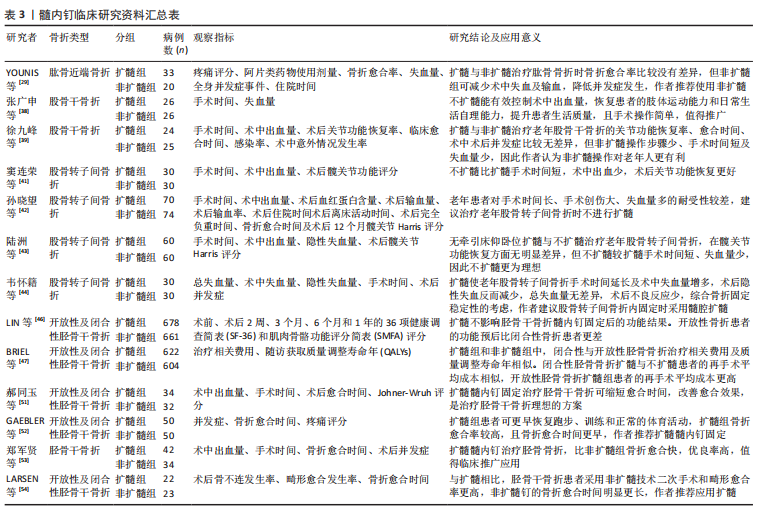
| [1] 张经,王斌,吕欣.解剖型髓内钉在四肢管状骨骨折治疗中的应用:把持与抗旋转能力更强[J].中国组织工程研究,2021,25(6):917-922. [2] BONG MR, KOVAL KJ, EGOL KA. The history of intramedullary nailing. Bull NYU Hosp Jt Dis. 2006;64(3-4):94-97. [3] BEKOS A, SIOUTIS S, KOSTROGLOU A, et al. The history of intramedullary nailing. Int Orthop. 2021;45(5):1355-1361. [4] ROSA N, MARTA M, VAZ M, et al. Intramedullary nailing biomechanics: Evolution and challenges. Proc Inst Mech Eng H. 2019;233(3):295-308. [5] 黄正.扩髓治疗骨折不愈合的生物学机理研究[D].上海:上海交通大学,2007. [6] 唐三元,杨辉.髓内钉治疗长骨骨折扩髓与不扩髓的争论[J].生物骨科材料与临床研究,2004,1(1):25-28. [7] 任强.扩髓与非扩髓髓内钉治疗成人胫骨干骨折的效果分析[D].张家口:河北北方学院,2018. [8] 熊军,余斌,欧阳汉斌,等.扩髓与非扩髓髓内钉固定治疗胫骨闭合性骨折的系统评价[J].中国矫形外科杂志,2011,19(24):2025-2029. [9] 许新忠,荆珏华,周云,等.髓内钉治疗胫骨骨折并发症分析[J].颈腰痛杂志,2012,33(2):133-134. [10] BRUMBACK RJ, VIRKUS WW. Intramedullary nailing of the femur: reamed versus nonreamed. J Am Acad Orthop Surg. 2000;8(2):83-90. [11] HEIM D, SCHLEGEL U, PERREN SM. Intramedullary pressure in reamed and unreamed nailing of the femur and tibia--an in vitro study in intact, human bones. Injury. 1993;24(1):S56-S63. [12] MOUSAVI M, DAVID R, SCHWENDENWEIN I, et al. Influence of controlled reaming on fat intravasation after femoral osteotomy in sheep. Clin Orthop Relat Res. 2002;394:263-270. [13] 陈中伟, 张俊飞, 杜武军, 等. 脂肪栓塞综合征诊治的临床研究进展[J].创伤外科杂志,2021,23(1):78-81. [14] KROPFL A, DAVIES J, BERGER U, et al. Intramedullary pressure and bone marrow fat extravasation in reamed and unreamed femoral nailing. J Orthop Res. 1999;17(2):261-268. [15] BAIG MN, CURTIN W. A simple and easy intramedullary lavage method to prevent embolism during and after reamed long bone nailing. Cureus. 2017;9(8):e1609. [16] WILLIS BH, CARDEN DL, SADASIVAN KK. Effect of femoral fracture and intramedullary fixation on lung capillary leak. J Trauma. 1999;46(4):687-692. [17] AOKI S, YOKOYAMA K, ITOMAN M. Effects of reamed or unreamed intramedullary nailing under non-damaged conditions on pulmonary function in sheep. J Trauma. 2005;59(3):647. [18] DEHGHAN N, SCHEMITSCH EH. Extended applications of the reamer-irrigator-aspirator (RIA) system. Injury. 2017;48(Suppl 1):S47-S51. [19] CLAES L. Improvement of clinical fracture healing - What can be learned from mechano-biological research? J Biomech. 2021;115:110148. [20] 徐绍勇.交锁髓内钉扩髓与否在治疗胫骨骨折中的临床比较研究[D].福州:福建中医药大学,2010. [21] 孙林,刘兴华,王雪松,等.带锁髓内钉治疗新鲜四肢长骨干骨折1224例疗效分析[J].中华骨科杂志,2005,25(3):129-135. [22] 罗先正,张薇.髓内钉的生物力学设计[J].中华骨科杂志,1997, 16(4):57-61. [23] KLEIN S. Reaming versus non-reaming in medullary nailing: interference with cortical circulation of the canine tibia. Arch Orthop Trauma Surg. 1990; 109(6):314-316. [24] SCHEMITSCH EH, KOWALSKI MJ, SWIONTKOWSKI MF, et al. Comparison of the effect of reamed and unreamed locked intramedullary nailing on blood flow in the callus and strength of union following fracture of the sheep tibia. J Orthop Res. 1995;13(3):382-389. [25] KLEIN C, SPRECHER C, RAHN BA, et al. Unreamed or RIA reamed nailing: an experimental sheep study using comparative histological assessment of affected bone tissue in an acute fracture model. Injury. 2010;41(11): S32-S37. [26] KALBAS Y, QIAO Z, HORST K, et al. Early local microcirculation is improved after intramedullary nailing in comparison to external fixation in a porcine model with a femur fracture. Eur J Trauma Emerg Surg. 2018;44(5):689-696. [27] GREKSA F, TÓTH K, BOROS M, et al. Experimental studies of microcirculatory changes in the bone. Magy Seb. 2012;65(4):178-183. [28] 李云,肖景,张光明.不扩髓逆行交锁髓内钉治疗肱骨中段骨折[J].广州医药,2005,36(4):30-31. [29] YOUNIS M, BARNHILL SW, MAGUIRE J, et al. Management of humeral impending or pathological fractures with intramedullary nailing: reaming versus non reaming technique-a retrospective comparative study. Musculoskelet Surg. 2020. doi:10.1007/s12306-020-00668-6. [30] BALTOV A, MIHAIL R, DIAN E. Complications after interlocking intramedullary nailing of humeral shaft fractures. Injury, 2013;45 (Suppl 1):S9-S15. [31] 崔智勇,田耘,冯辉,等.顺行髓内钉固定治疗12-A型肱骨干骨折中医源性骨折的研究[J].中华创伤骨科杂志,2018,20(1):10-15. [32] 赵宝成,马宝通,刘林涛,等.带锁髓内钉治疗526例长骨骨折疗效分析[J].中华骨科杂志,2005,25(3):136-142. [33] HUSEBYE EE, LYBERG T, OPDAHL H, et al. Intravasation of bone marrow content. Can its magnitude and effects be modulated by low pressure reaming in a porcine model? Injury. 2010;41:S9-S15. [34] BAUR M, WEBER B, LACKNER I, et al. Structural alterations and inflammation in the heart after multiple trauma followed by reamed versus non-reamed femoral nailing. PLoS One. 2020;15(6):e0235220. [35] LACKNER I, WEBER B, MICLAU T, et al. Reaming of femoral fractures with different reaming irrigator aspirator systems shows distinct effects on cardiac function after experimental polytrauma. J Orthop Res. 2020; 38(12):2608-2618. [36] DUAN X, LI T, MOHAMMED AQ, et al. Reamed intramedullary nailing versus unreamed intramedullary nailing for shaft fracture of femur: a systematic literature review. Arch Orthop Trauma Surg. 2011;131(10): 1445-1452. [37] 王雄,戴七一,李书振.扩髓与不扩髓条件下髓内钉置入内固定治疗成人股骨干骨折的系统评价[J].中国组织工程研究,2012,16(26): 4812-4816. [38] 张广申.对比分析髓内钉扩髓、不扩髓治疗老年股骨干骨折的效果[J].中国伤残医学,2017,25(8):34-36. [39] 徐九峰,李冬梅,李玉祥,等.老年股骨干骨折患者采用髓内钉扩髓与不扩髓治疗的比较[J].中国老年学杂志,2014,34(13):3596-3597. [40] 吴克俭,汤俊君.成人股骨干骨折髓内钉治疗需要关注的问题[J].中华创伤骨科杂志,2020,22(11):921-926. [41] 窦连荣,窦帮,朱玮,等.老年粗隆间骨折中亚洲型PFNA使用导针扩髓与否的疗效比较[J].组织工程与重建外科杂志,2015,11(5): 327-330. [42] 孙晓望,梁凡,邓明.股骨近端防旋髓内钉扩髓与否对老年股骨转子间骨折的疗效影响[J].临床骨科杂志,2020,23(6):854-857. [43] 陆洲,孙奇,裘晓冬,等.无牵引床仰卧位不扩髓与扩髓股骨近端防旋髓内钉内固定治疗老年股骨转子间骨折的比较研究[J].中医正骨,2017, 29(9):15-18. [44] 韦怀籍,周建飞,徐攀峰.股骨近端防旋髓内钉术中扩髓对手术失血量的影响[J].中国医药导报,2016,13(12):81-84. [45] WISS DA, STETSON WB. Unstable fractures of the tibia treated with a reamed intramedullary interlocking nail. Clin Orthop Relat Res. 1995; (315):56-63. [46] LIN CA, SWIONTKOWSKI M, BHANDARI M, et al. Reaming does not affect functional outcomes after open and closed tibial shaft fractures: the results of a randomized controlled trial. J Orthop Trauma. 2016; 30(3):142-148. [47] BRIEL M, SPRAGUE S, HEELS-ANSDELL D, et al. Economic evaluation of reamed versus unreamed intramedullary nailing in patients with closed and open tibial fractures: results from the study to prospectively evaluate reamed intramedullary nails in patients with tibial fractures (SPRINT). Value Health. 2011;14(4):450-457. [48] 万云华.扩髓与不扩髓交锁髓内钉治疗胫骨骨折的比较分析[J].中国医师进修杂志,2012,35(14):49-50. [49] LI CX, ZHAO HJ, ZHAO WQ, et al. System evaluation on reamed and non-reamed intramedullary nailing in the treatment of closed tibial fracture. Acta Cir Bras. 2013;28(10):744-750. [50] 努尔哈那提·沙依兰别克,金格勒,杨毅,等.扩髓与非扩髓髓内钉修复成人胫骨干骨折的系统评价[J].中国组织工程研究,2016, 20(39):5912-5918. [51] 郝同玉.扩髓与非扩髓型交锁髓内钉治疗胫骨干骨折患者的疗效[J].医疗装备,2017,30(1):136-137. [52] GAEBLER C, MCQUEEN MM, VÉCSEI V, et al. Reamed versus minimally reamed nailing: a prospectively randomised study of 100 patients with closed fractures of the tibia. Injury. 2011;42(suppl 4):S17-S21. [53] 郑军贤,程迅生,郑国海,等.扩髓交锁髓内钉治疗胫骨骨折的疗效[J].安徽医学,2015,36(7):862-864. [54] LARSEN LB, MADSEN JE, HOINESS PR, et al. Should insertion of intramedullary nails for tibial fractures be with or without reaming? a prospective, randomized study with 3.8 years’ follow-up. J Trauma. 2004;18(3):144-149. [55] 田晓华,赵敏,闫红旗,等.扩髓产物留取装置的研制与临床应用初步报告[J].中国矫形外科杂志,2010,18(22):1915-1917. [56] HALVACHIZADEH S, TEUBEN M, LEMPERT M, et al. Protective effects of new femoral reaming techniques (Reamer irrigator aspirator, RIA I and II) on pulmonary function and posttraumatic contusion (CT morphology) - results from a standardized large animal model. Injury. 2021;52(1):26-31. [57] JAKMA TS, RÖLING MA, PUNT B, et al. More adverse events than expected in the outcome after use of the reamer-irrigator-aspirator. Eur J Trauma Emerg Surg. 2014;40(3):337-341. |
| [1] | Wang Jianping, Zhang Xiaohui, Yu Jinwei, Wei Shaoliang, Zhang Xinmin, Xu Xingxin, Qu Haijun. Application of knee joint motion analysis in machanism based on three-dimensional image registration and coordinate transformation [J]. Chinese Journal of Tissue Engineering Research, 2022, 26(在线): 1-5. |
| [2] | Li Rui, Shi Wen, Yang Shicai, Lü Linwei, Zhang Chunqiu. Effect of splintage and Shenxiaosan cataplasm on fracture healing in rabbits with radial fracture model [J]. Chinese Journal of Tissue Engineering Research, 2022, 26(9): 1329-1333. |
| [3] | Zhang Yufang, Lü Meng, Mei Zhao. Construction and verification of a full spine biomechanical model of adolescent scoliosis [J]. Chinese Journal of Tissue Engineering Research, 2022, 26(9): 1351-1356. |
| [4] | Bai Zixing, Cao Xuhan, Sun Chengyi, Yang Yanjun, Chen Si, Wen Jianmin, Lin Xinxiao, Sun Weidong. Construction and biomechanical analysis of ankle joint finite element model in gait cycle [J]. Chinese Journal of Tissue Engineering Research, 2022, 26(9): 1362-1366. |
| [5] | Liu Feng, Feng Yi. Finite element analysis of different Kirschner wire tension bands on transverse patella fractures during gait cycle [J]. Chinese Journal of Tissue Engineering Research, 2022, 26(9): 1367-1371. |
| [6] | Wen Mingtao, Liang Xuezhen, Li Jiacheng, Xu Bo, Li Gang. Mechanical stability of Sanders II type calcaneal fractures fixed by two internal fixation methods [J]. Chinese Journal of Tissue Engineering Research, 2022, 26(6): 838-842. |
| [7] | Huang Hao, Hong Song, Wa Qingde. Finite element analysis of the effect of femoral component rotation on patellofemoral joint contact pressure in total knee arthroplasty [J]. Chinese Journal of Tissue Engineering Research, 2022, 26(6): 848-852. |
| [8] | Zheng Yongze, Zheng Liqin, He Xingpeng, Chen Xinmin, Li Musheng, Li Pengfei, Lin Ziling. Extended finite element modeling analysis of femoral neck fracture based on ABAQUS software [J]. Chinese Journal of Tissue Engineering Research, 2022, 26(6): 853-857. |
| [9] | Liu Yuhang, Zhou Jianqiang, Xu Xuebin, Qu Xingyue, Li Ziyu, Li Kun, Wang Xing, Li Zhijun, Li Xiaohe, Zhang Shaojie. Establishment and validation of finite element model of lower cervical spine in 6-year-old children [J]. Chinese Journal of Tissue Engineering Research, 2022, 26(6): 870-874. |
| [10] | Duan Chao, Shang Xiaoqiang, Duan Xianglin, Yang Ping, Tao Shengxiang. Stability of patellar claw versus loop plate combined with patellar claw for the treatment of comminuted fractures of the lower pole of the patella [J]. Chinese Journal of Tissue Engineering Research, 2022, 26(6): 934-937. |
| [11] | Baibujiafu·Yelisi, Renaguli·Maihemuti, Aizimaitijiang·Saiyiti, Wang Junxiang, Nijiati·Tuerxun. Stress analysis of maxillary central incisor crown implant restoration in different occlusal modes [J]. Chinese Journal of Tissue Engineering Research, 2022, 26(4): 567-572. |
| [12] | Chen Jinmin, Chen Suisheng, Ding Jing, Xia Baoquan, Luo Xiaojia, Lu Chenghai. Stability of balloon dilation with injectable calcium sulfate cement for tibial plateau fractures [J]. Chinese Journal of Tissue Engineering Research, 2022, 26(3): 414-418. |
| [13] | Yang Ruijia, Jiang Lingkai, Dong Zhengquan, Wang Yunfei, Ma Zhou, Cong Linlin, Guo Yanjing, Gao Yangyang, Li Pengcui. Open reduction and internal fixation versus circular external fixation for tibial plateau fractures: a meta-analysis [J]. Chinese Journal of Tissue Engineering Research, 2022, 26(3): 480-486. |
| [14] | Li Lu, Tang Wen. Screw placement in posterior route pedicle on subaxial cervical spine: how to improve the therapeutic effect with the development of artificial intelligence [J]. Chinese Journal of Tissue Engineering Research, 2022, 26(3): 474-479. |
| [15] | Li Yanting, Chen Jian, Liu Menglan, Ren Manman, Zhong Weihong, Chen Changxing. Three-dimensional finite element analysis of Daogaijinbei manipulation on lumbar intervertebral disc biomechanics [J]. Chinese Journal of Tissue Engineering Research, 2022, 26(3): 340-343. |
| Viewed | ||||||
|
Full text |
|
|||||
|
Abstract |
|
|||||
